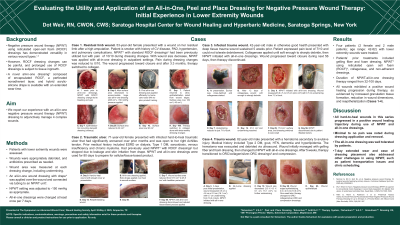Case Series/Study
(CS-168) Evaluating the Utility and Application of an All-in-one, Peel and Place Dressing for Negative Pressure Wound Therapy: Initial Experience in Lower Extremity Wounds
Friday, May 2, 2025
7:45 PM - 8:45 PM East Coast USA Time

Introduction: Negative pressure wound therapy (NPWT) using reticulated open-cell foam (ROCF) dressings has been in use for 3 decades demonstrating reduced dressing changes, improved granulation tissue and perfusion, periwound edema reduction and enhanced wound contraction. The current devices utilizing reticulated open cell foam (ROCF) can be time consuming to apply and guidelines recommend three times a week dressing changes. Additionally, prolonged wear of ROCF dressings is subject to tissue ingrowth and potential pain during removal.
Methods: A novel, all-in-one, peel and place NPWT dressing with an extended wear time and a perforated non-adherent layer3 designed to improve ease of application and to help reduce risk of tissue ingrowth was evaluated in patients with complex wounds.
Results: Patients with lower extremity wounds were assessed. Wounds were appropriately debrided, assessed for infection and antibiotics prescribed as needed. Wounds were measured (at presentation and dressing changes) and any undermining was noted. The peel and place dressing* was applied over the wound. NPWT† setting was adjusted up to -150 mmHg as required. Peel and place dressings were worn for up to 7 days before changing.
Discussion: Four patients (2 female and 2 male patients; mean age = 62.0±17.9 years) with lower extremity wounds presented for care. Three patients were multimorbid and one patient had no remarkable medical history. Treated wounds included a hematoma post avulsive injury, an open wound over the Achilles, a deep tissue trauma wound, and a high above-knee amputation stump. Patients’ prior treatments included gelling fiber and foam dressing, NPWT using ROCF, collagenase, and/or non-adhering dressings. Wounds managed with NPWT using the peel and place dressing exhibited granulation tissue formation, reduction in wound dimension, and re-epithelialization.
In these 4 patients with lower extremity wounds, the peel and place dressing afforded improved healing outcomes within the continuum of wound management. The peel and place dressing was well tolerated with patients noting significant improvement in pain to minimal to no pain. Extended wear and ease of dressing placement also addressed other challenges in using NPWT such as reduction/elimination of home care visits, patient transportation issues and clinic scheduling.
Methods: A novel, all-in-one, peel and place NPWT dressing with an extended wear time and a perforated non-adherent layer3 designed to improve ease of application and to help reduce risk of tissue ingrowth was evaluated in patients with complex wounds.
Results: Patients with lower extremity wounds were assessed. Wounds were appropriately debrided, assessed for infection and antibiotics prescribed as needed. Wounds were measured (at presentation and dressing changes) and any undermining was noted. The peel and place dressing* was applied over the wound. NPWT† setting was adjusted up to -150 mmHg as required. Peel and place dressings were worn for up to 7 days before changing.
Discussion: Four patients (2 female and 2 male patients; mean age = 62.0±17.9 years) with lower extremity wounds presented for care. Three patients were multimorbid and one patient had no remarkable medical history. Treated wounds included a hematoma post avulsive injury, an open wound over the Achilles, a deep tissue trauma wound, and a high above-knee amputation stump. Patients’ prior treatments included gelling fiber and foam dressing, NPWT using ROCF, collagenase, and/or non-adhering dressings. Wounds managed with NPWT using the peel and place dressing exhibited granulation tissue formation, reduction in wound dimension, and re-epithelialization.
In these 4 patients with lower extremity wounds, the peel and place dressing afforded improved healing outcomes within the continuum of wound management. The peel and place dressing was well tolerated with patients noting significant improvement in pain to minimal to no pain. Extended wear and ease of dressing placement also addressed other challenges in using NPWT such as reduction/elimination of home care visits, patient transportation issues and clinic scheduling.

.jpg)

